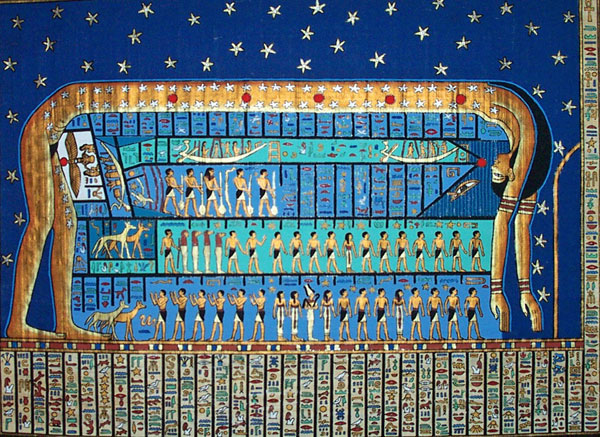
In Ancient Egypt blue (irtyu) was the colour of the heavens and hence represented the universe. Many temples, sarcophagi and burial vaults have a deep blue roof speckled with tiny yellow stars.

Blue is also the colour of water and hence the colour of the Nile and the primeval waters of chaos (known as Nun). As a result, the colour blue was associated with fertility, rebirth, and the power of creation. Blue glass or faience hippopotami were popular symbols of the Nile and the creator god Amun was often depicted with a blue face. According to myth, the hair of the gods was made of precious Lapis Lazuli (khesbedj). A number of Pharaohs imitated the god and were depicted in art with blue faces or hair.

Baboons were often depicted as blue to emphasise their connection with Thoth whose primary totem was the Ibis bird with its blue plumage. The phoenix, symbolising the primeval flood and rebirth, was based on the heron. Although heron actually have blue-grey plumage, in Egyptian art they were given bright blue feathers.




For painting the ancient Egyptians made blue pigments out of a number of minerals, including azurite (tefer) and copper (bia). However, the most famous and prized pigment was “Egyptian blue” (irtyu) which was made by boiling quartz (silica) with copper (in the form of malachite), calcium carbonate and natron. This was expensive and tricky to make, but produced a beautiful deep blue colour which was very popular. The Romans referred to this pigment as”caeruleum”, the root of the English colour “cerulean”.
The Egyptians used Lapis Lazuli and blue glass to great effect in their jewellery. Although turquoise is often a beautiful aqua-blue, the Egyptians associated it more closely with the colour green.

Lapis beads found in burial sites from the Predynastic Period provide evidence that, even at this early time, the ancient Egyptians traded commodities with their fairly distant neighbours in the Euphrates valley. Its dark blue colour symbolised fertility and good luck. Feldspar was mined in the eastern desert. It is a lighter blue colour, but also symbolised good luck and fertility.
Copyright J Hill 2010